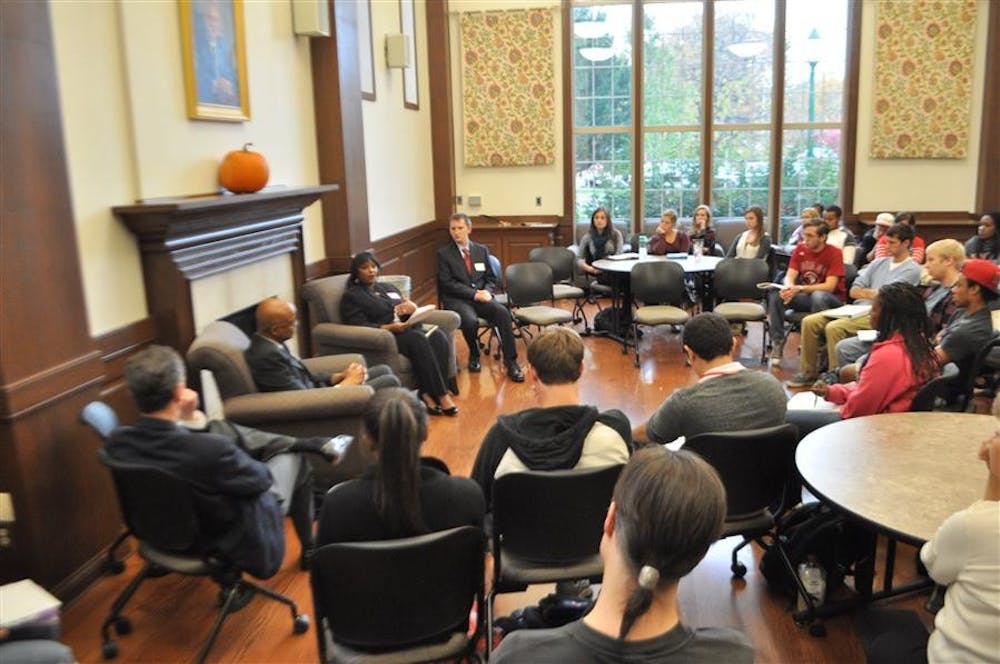On Sept. 16, 1968, a young black woman set out to sell a stack of encyclopedias in Martinsville, Ind.
She never came home.
That night, Carol Jenkins was murdered with a screwdriver at 21 years old.
Although the Jenkins family was desperate to find out what had happened to their daughter, more than three decades passed without any answers.
By the time reporter Sandra Chapman took her post at WISH-TV, Jenkins was nothing but a “cold case” — one among many unsolved crimes collecting dust in a forgotten corner.
Refusing to accept the silence, Chapman launched an investigation in 2001 that eventually cracked the case.
At an IU Themester event on Wednesday she spoke of her experience and discussed “The Girl with the Yellow Scarf,” her nonfiction book detailing the case.
“It was one of Indiana’s most notorious cold case murders,” she said. “This story captivated me and became the passion of my heart.”
Chapman first became interested in the story when she was warned by fellow reporters to never go to Martinsville alone — especially after dark.
It was then she learned of Jenkins.
“I wanted to know more. I wanted to dig,” Chapman said. “In a small town, everyone knows everybody and everyone’s business. How did no one know what happened?”
As she began working on the story, Chapman faced resistance from the Martinsville residents, who resented her intrusion, and from the state police, who were concerned about their reputation.
In November 2001 she discovered that the original primary suspect for the case, supposedly killed in a shooting in another state, was actually alive.
“No one ever really checked or verified it,” she said.
After this story was released, Chapman received a voicemail that completely changed the investigation’s direction.
“The voicemail said, ‘If the girl had a yellow scarf and was killed with a screwdriver, my father could be the killer,’” Chapman said. “It gave me shivers. It still does now, thinking about it.”
The woman who left the voicemail knew something only a witness could know.
Jenkins’ scarf had never been included in any information released to the public.
“Shirley McQueen was trying to unburden herself from a devastating secret,” Chapman said.
McQueen was just 7 years old when she witnessed the murder from the backseat of her father’s car. Afterwards, Kenneth Richmond gave her $7 and told her to “keep her mouth shut.”
Richmond was an alcoholic who regularly abused his wife and children, Chapman said.
He was also deeply troubled and so tormented by his failures that he castrated himself.
Above all, Richmond was open about his hatred of blacks. He told his daughters he would kill them if they ever brought home black men.
“Shirley had two choices,” Chapman said. “She could either muster up the courage to go against her father, or she could tell herself that it wasn’t her place to get involved.”
Instead of condemning McQueen for her prolonged silence, Chapman said it was important to realize how much turmoil and suffering McQueen had gone through.
She faced rejection from her family and father, and she was terrified of how her life might change if she revealed the truth.
The two women began a correspondence that would last for years.
As Chapman continued her investigations, the state police demanded she present all her notes and records.
They eventually took her to court.
She refused to comply, stating that sources would refuse to talk to her if she gave her notes to anyone.
“This was during the time when journalists were beginning to get arrested for not giving information,” she said. “My friend asked me, ‘Are you ready to go to jail for this?’ And I guess I was.”
The court sided with her, and the investigation plunged on.
Thanks to the information McQueen revealed to Chapman, the police were able to arrest and charge Richmond with murder.
He died of cancer before trial, but he allegedly admitted to the killing while in custody.
After his arrest, McQueen became an instant celebrity when shows and stations such as CBS, “Dateline” and “60 Minutes” reached out.
“It was her life, and she didn’t want to have anything to do with them,” Chapman said. “She eventually came forward and asked me to write the story because she felt that she could trust me.”
It took Chapman eight years to write the book. She said it was a project that stirred up many emotions and consumed her thoughts.
“I knew Carol’s family’s frustration and their desire for answers, but I also knew Shirley was in real pain,” she said. “I wanted to help her, too.”
Journalist discusses book, crime

Get stories like this in your inbox
Subscribe





